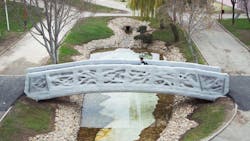3D-Printed Steel Bridge Lays Pathway to Manufacturing's Future
Nearly three years ago, the Dutch startup MX3D captured the imaginations of the additive manufacturing community by announcing it would 3D-print an entire stainless steel bridge using robotic printers, intimating at how the future of construction and manufacturing may look. This month it was announced that the bridge has finally been completed—and it looks amazing, in an H.R. Giger sort of way.
Take a look at the photo gallery above to see its development.
The bridge was completed at MX3D’s facility in Amsterdam, using four six-axis robots over a six month span, and the curvy beauty is expected to be installed in the red light district, over the city’s Oudezijds Achterburgwal Canal, sometime next year.
“The goal of the MX3D Bridge project is to showcase the potential applications of our multi-axis 3D printing technology,” MX3D describes on its website.
The 41-feet-long, 20-feet wide bridge also demonstrates what happens when industrial experts team up on emerging technology projects. Autodesk assisted with digital tools, ArcelorMittal with metalworking, and Lenovo with hardware. As more manufacturers apply their expertise, we should expect an exponential increase in scale and ambition of new additive ventures.
Designer Joris Laarman Lab commented on its blog: “It feels like the discovery of a new continent. A world of new opportunities is in front of us but we can only just see its contours.”
This will not be the first 3D-printed bridge Dutch capital. In 2017, a separate team 3D-printed concrete to build a short cyclist bridge. The very first 3D printed bridge was finished in Madrid in January 2017. Designed by the Institute of Advanced Architecture of Catalonia, the 40-foot pedestrian crossing is functional, though the material used, fused concrete powder micro-reinforced with thermoplastic polypropylene, made for a less-than-crisp final form. It resembles a sloppy ceramic art project a middle schooler would gift mom for her birthday. That's not a knock on project team; it just shows how nascent the technology is
Also last year, the San Francisco-based Apis Cor unveiled its 3D-printed house in Russia, which took only a day to build.
As more companies experiment with various mediums, and find ways to add each layer faster, the benefits manufacturers have already discovered, such as economical use of material and unbound geometrical expression, will be visible in every part of our lives, from what’s underfoot as we commute to work to where we rest our heads at night.
"The symbolism of the bridge is a beautiful metaphor to connect the technology of the future with the old city, in a way that brings out the best of both worlds," Laarman said back in 2015.
That’s till the most apt description of the project, and what 3D printing represents for all of us.
About the Author
John Hitch
Editor, Fleet Maintenance
John Hitch, based out of Cleveland, Ohio, is the editor of Fleet Maintenance, a B2B magazine that addresses the service needs for all commercial vehicle makes and models (Classes 1-8), ranging from shop management strategies to the latest tools to enhance uptime.
He previously wrote about equipment and fleet operations and management for FleetOwner, and prior to that, manufacturing and advanced technology for IndustryWeek and New Equipment Digest. He is an award-winning journalist and former sonar technician aboard a nuclear-powered submarine where he served honorably aboard the fast-attack submarine USS Oklahoma City (SSN-723).

